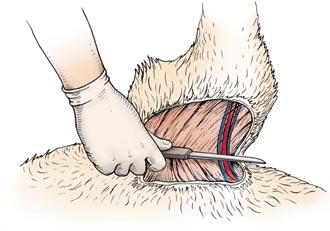Exanguination
Once the animal has been rendered unconscious, exsanguination procedures should be initiated to ensure death using a pointed, very sharp knife with a rigid blade at least 6 inches (15 cm) in length. As indicated previously, exsanguination procedures are required with the use of penetrating captive bolt. The knife should be fully inserted through the skin just behind the point of the jaw and below the neck bones. From this position the knife is drawn forward severing the jugular vein, carotid artery, and windpipe. Properly performed, blood should flow freely with death occurring within a few minutes (See diagram below).
Alternatively, one may sever the brachial vasculature by lifting a front leg and inserting the knife deeply into the auxiliary area at the point of the elbow and cutting the skin, blood vessels, and surrounding tissue until the limb can be laid back away from the thorax of the animal. Regardless of the method used, great care should be exercised in performing exsanguination procedures. Although unconscious, animals in this state are capable of violent involuntary movement that may cause personal injury (See diagram below).
Pithing
Pithing is a technique designed to cause death by increasing the destruction of brain tissue. It is performed by inserting a pithing rod or tool through the entry site produced in the skull by the penetrating captive bolt stunner. The operator manipulates the pithing tool to destroy both brain stem and spinal cord tissue which ensures death. This procedure is sometimes used in advance of exsanguination procedures to reduce involuntary movement in stunned animals.
Intravenous Injection of KCl
Another option of ensuring death once the animal has been rendered unconscious is through the injection of a saturated solution (340 grams in 1 liter of water) of potassium chloride (KCl). Potassium chloride is a salt solution which when delivered by rapid intravenous injection induces cardiac arrest. Normally, the injection of a 120 ml of a saturated solution of KCl is sufficient to cause death. It is advised that when conducting euthanasia that may require KCl, the operator prepare two 60 ml syringes with KCl solution and needles (14 or 16 gauge 11/2 inch or 4 cm) prior to rendering the animal unconscious. Any available vein may be used; however it is important to position oneself out of the reach of feet and legs which may cause injury during periods of involuntary movement. In most cases, it is safest to kneel close behind the animal's head and neck (out of range of feet and legs) and reach over the neck to deliver the intravenous injection into the jugular vein. Once the needle is in the vein, the injection should be delivered by rapid intravenous injection. Death will usually occur within a couple of minutes.
Please note that KCL should never be used in conscious animals. Potassium chloride (KCl) causes death by inducing cardiac arrest.

Please note that KCL should never be used in conscious animals. Potassium chloride (KCl) causes death by inducing cardiac arrest.
Solubility of KCl
This solution should be made in advance (of any possibility of needing to euthanize an animal) and clearly marked “For use as a secondary step ONLY (e.g. after captive bolt) for Euthanizing animals.”
If possible, mix on a heated stir plate (optimal), place mixing vessel (beaker, flask, etc.) on the cold plate with 1 liter(1.O6 quarts) of water with stir bar and add the appropriate amount of Potassium Chloride (340 grams for room temperature). As seen in the Table below, please be aware that some KCl will come out of solution as it gets colder.
Amount of KCl to add to water (solubility) to reach a saturated solution based on temperature
|
Water |
0oC (32oF) |
10oC (50oF) |
20oC (68oF) |
30oC (86oF) |
40oC (104oF) |
50oC (122oF) |
|---|---|---|---|---|---|---|
|
100 mL (3.4 oz.) |
27.6 g |
31.0 g |
34.0 g |
37.0 g |
40.0 g |
42.6 g |
|
1 L (1.06 quarts) |
276 g |
310 g |
340 g |
370 g |
;400 g |
426 g |
Adapted from: Online Introductory Chemistry, Solubility: How solubility is measured
